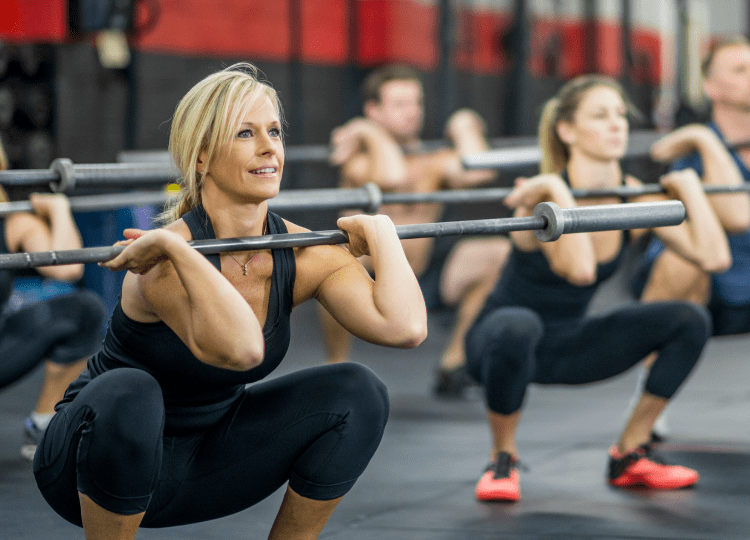The Asian squat is a deep squat that has strong cultural ties with numerous Asian countries. A seemingly simple exercise, it has grabbed international headlines and made many people in Western countries realize that they are actually unable to hold such a deep squat.
So why is the Asian squat so difficult for certain nationalities? And are there any benefits to be had from doing them?
We’ve got you covered…
This article delves into everything you need to know about Asian squats and tips for mastering this trending exercise. From the biomechanics of getting your glutes that low to the ground, to why those of Asian nationalities appear to be much better at the exercise, we take you on a journey through cultural significance and lower body mobility to provide a clear overview of this phenomenon.

Quick Summary
- An Asian squat is a deep squat where the heels remain on the floor.
- It requires good mobility at the hips, knees and ankles.
- Lifestyle factors (e.g., being sedentary) can contribute to limited lower body mobility that ultimately makes the Asian squat challenging for many.
- There are lots of exercises you can do to improve the depth and stability of your Asian squat.
What are Asian Squats?
An Asian squat is a term that describes the common deep squatting position that can be witnessed in many Asian countries.
It is basically just a deep squat, but it’s the cultural context that is important. People adopt this squatting position for all sorts of activities, from reading, relaxing, doing housework, to even using the toilet… this squatting position is a staple in many people’s daily life.
It’s also not uncommon to eat meals in this position too… which requires holding such a position for longer periods, highlighting the fact many Asian nationals will naturally spend a lot of time in this deep squat.
It’s often the preference to squat like this compared to just sitting on the floor or sitting on a toilet seat, as it is seen as more hygienic.

From street corners, to parks and living rooms, people will often adopt this so-called “Asian squat” position. By doing the Asian squat, it acts as a substitute for using a chair.
If you’re using a squat toilet on a daily basis, it’s no surprise that your muscles get used to this position and that certain nationalities appear to embrace this deep squat better than others.
And this is all very important… because this illustrates that the Asian squat isn’t considered an exercise in such communities, but rather a relaxing pose that can be held for long periods.
Until recently, this was predominantly ignored in Western countries until the clear health and fitness benefits that this style of squatting offers was highlighted. As the functional fitness movement continues to gain pace, exercises that replicate real world movements and requirements are considered highly valued for our overall wellbeing.
During an Asian squat, the feet are kept flat on the ground, which means there is greater range of motion at the hips and ankles compared to a Western style squat. Many Westerners will naturally lift the heel to accommodate a deep squat or lean forward, illustrating limited mobility around the hips and ankles.
Once you master the Asian squat, you’ll find it helps support all sorts of exercises (such as ground to overhead exercises) and allows you to engage muscles like the quads, glutes and hamstrings more, as you can squat deeper with weights too.

Is the Asian Squat Genetics?
Although genetics will influence things like bone length and shape in the hip joint and legs (as well as collagen and ligament attributes), the ability to do a deep Asian squat is much more likely to do with lifestyle factors, as opposed to genetics.
Although longer legs may mean that it’s biomechanically harder to get into a deep squat, the defining factors are going to be around flexibility and range of motion in the hips, knees and ankles.
If you are of Asian heritage but spend all your day sat at a computer, you may find you have tight hips and ankles, and ultimately struggle with any sort of deep squat. Similarly, if you’re American or European, and you work on improving your hip and ankle flexibility and range of motion, there’s no reason why you can’t master the Asian squat.
Just because you’re Asian, there’s no guarantee you’ll be able to do this deep squat… but if you avoid spending long periods sitting (whether by choice or by your cultural setting), and include lower body mobility exercises in your fitness routine, it’s likely your hips, knees and ankles are going to have the flexibility and mobility needed to hold such a position.
Losing Natural Flexibility As We Age
How to Asian Squat
To do an Asian Squat, stand with your feet shoulder width apart with your feet pointing forwards. Slowly lower yourself into a deep squatting position. Keep your back as upright as possible and keep your heels touching the floor. Try and relax into the position and hold it for a few minutes.
Perfecting the Asian squat requires more than just strong glutes or hamstrings… it’s a movement that requires good hip and ankle mobility – something lots of us don’t have!
For anyone who can’t do an Asian squat, the chances are, it often boils down to poor mobility around the ankles, hips, and knees, or tight calves. These are likely to be the defining characteristics that limit some people’s ability to Asian squat.
Watch the video below to learn how to do an Asian squat.
Are Asian Squats Good for You?
Asian squats are good for mobility, flexibility and lower body strength.
If you imagine Olympic weightlifting movements, adopting an Asian squat puts the weight on the legs, as opposed to taking more of the weight on your back which can often lead to injury. This leads to better performance of many fitness exercises, helping strengthen muscles and lower the risk of injuries.
If you’re keen to start CrossFit or Olympic lifting workouts, being able to do deep squats will be prioritised – so it’s worth giving it a practice!
One of our favorite YouTubers, Fabulous 50s, discusses the Asian squat in her video, Best Exercise for Women Over 50, below.
Benefits of Asian Squats
Asian squats offer a range of benefits, including:
- Combat the Problems Associated with Sitting
- Strengthen Legs
- Improves Posture
- Improve Ankle Mobility and Flexibility
- Promotes Better Positioning for Olympic Lifting Exercises
- Useful During Pregnancy to Alleviate Pain
- Reduce Tight Calves
- Reduces Pressure on Joints and Bones
- Combat Lower Back Pain
- Improves Digestion and Bowel Movements
An additional benefit of the Asian Squat is for those adventurous travellers out there, who long to explore Asia and the Far East. Bathroom visits in these countries can often require a strong squat so its always good to know you won’t be left struggling to balance when mother nature calls!
There is also a growing trend in the US and parts of Europe, around ditching traditional toilet seats and positions, to adopt the more ancestral squatting style (reflecting that of Asian squats). It is argued that it could help improve bowel movements for many of us. The Squatty Potty is a product that helps achieve this and is highly rated by many.
Slow and Steady Improvements
Asian Squat vs Slav Squat
For all intents and purposes, the Asian and “Slav” squat are largely the same. Again, the term “Slav” squat carries cultural reference from Eastern European countries and describes a deep squat.
In terms of differences, the Slav squat has a wider base, with the feet placed shoulder width apart or wider, compared to the Asian squat which is often narrower.
There are also other squats that have cultural reference, including the Hindu squat.
Adding Asian Squats into your Daily Routine
There are 2 ways to gain the benefits of Asian squats.
Firstly, you could add some sets of Asian squats into your workout routines. If doing this, remember the benefits are often in holding the position too, so try and keep the Asian squat position for a little while on each repetition.
Secondly, it is to simply try Asian squats at home and remain in this position for as long as you can. You could be watching TV, using your laptop, or doing all sorts. By swapping sitting with squatting, you’ll gain lots of benefits without it requiring more time at the gym or working out.
Asian Squat Challenge
Here is our challenge to you – Swap 10 minutes of sitting a day with Asian squatting. Do this for 30 days and see how you feel afterwards. If you can’t do an Asian squat to begin with, try holding onto something like a chair or table for support – but ensuring your buttocks are as low as possible and your feet are flat on the ground.
We’re confident after 30 days, you’ll notice the difference and never fail to do your Asian squats again.
Bottom Line
The Asian squat requires good hip, knee and ankle mobility… and consequently, many people in Western countries often struggle with it.
This deep squat variation brings lots of benefits and is a good biomarker of lower body mobility.
If you’re struggling with it, try and include more hip mobility exercises, knee strengthening and mobility exercises and movements to improve ankle stability and range of motion.
Related Articles
How to do Glute Cable Kickbacks
